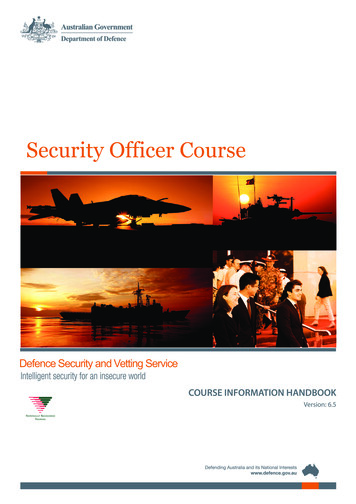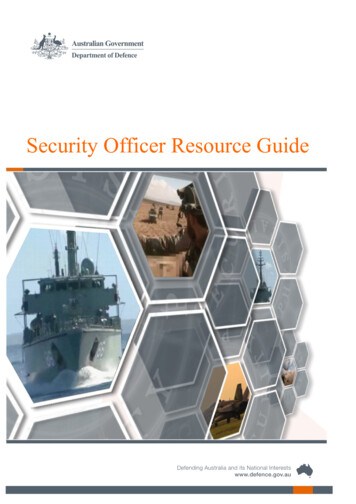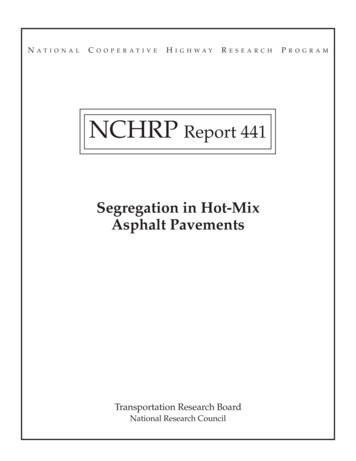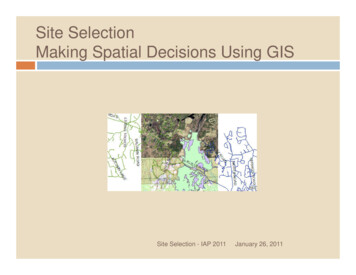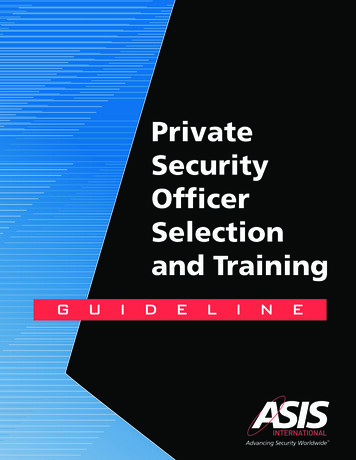
Transcription
PrivateSecurityOfficerSelectionand Training
ASIS INTERNATIONALCOMMISSION ON GUIDELINESThe Commission on Guidelines was established in early 2001 by ASISInternational (ASIS) in response to a concerted need for guidelinesregarding security issues in the United States. As the preeminentorganization for security professionals worldwide, ASIS has animportant role to play in helping the private sector secure its businessand critical infrastructure, whether from natural disaster, accidents,or planned actions, such as terrorist attacks, vandalism, etc. ASIShad previously chosen not to promulgate guidelines and standards,but world events have brought to the forefront the need for aprofessional security organization to spearhead an initiative to createsecurity advisory provisions. By addressing specific concerns andissues inherent to the security industry, security guidelines will betterserve the needs of security professionals by increasing theeffectiveness and productivity of security practices and solutions, aswell as enhancing the professionalism of the industry.Mission StatementTo advance the practice of security through the development of riskmitigation guidelines within a voluntary, non-proprietary, andconsensus-based process utilizing to the fullest extent possible theknowledge, experience, and expertise of ASIS membership and thesecurity industry.Goals and Objectives Assemble and categorize a database of existing security-relatedguidelines Develop methodology for identifying new guideline developmentprojects Involve/organize ASIS Councils to support guidelinedevelopment Identify and develop methodology for development,documentation, and acceptance of guidelines Develop and sustain alliances with related organizations tobenchmark, participate, and support ASIS guidelinedevelopment Produce national consensus-based guidelines in cooperationwith other industries and the Security Industry Standards CouncilFunctions Establish guideline projectDetermine guidelines for development and assign scopeAssign participating Council(s), where appropriateApprove membership on guideline committeeAct as a governing body to manage and integrate guidelinesfrom various Councils and security disciplines Review and monitor projects and guideline developmentApprove Final Draft Guideline and Final GuidelineSelect guidelines for submission to the Security IndustryStandards Council and the American National Standards Institute(ANSI)
Private Security Officer (PSO) Selection and Training GuidelineTMPRIVATE SECURITY OFFICERSELECTION AND TRAININGGUIDELINEASIS GDL PSO 11 2004
Private Security Officer (PSO) Selection and Training GuidelineCopyright 2004 by ASIS InternationalISBN 1-887056-57-2ASIS International (ASIS) disclaims liability for any personal injury, property, or other damagesof any nature whatsoever, whether special, indirect, consequential, or compensatory, directly orindirectly resulting from the publication, use of, or reliance on this document. In issuing andmaking this document available, ASIS is not undertaking to render professional or other servicesfor or on behalf of any person or entity. Nor is ASIS undertaking to perform any duty owed byany person or entity to someone else. Anyone using this document should rely on his or her ownindependent judgment or, as appropriate, seek the advice of a competent professional indetermining the exercise of reasonable care in any given circumstance.All rights reserved. Permission is hereby granted to individual users to download this documentfor their own personal use, with acknowledgment of ASIS International as the source. However,this document may not be downloaded for further copying or reproduction nor may it be sold,offered for sale, or otherwise used commercially.Printed in the United States of America10 9 8 7 6 5 4 3 2 1ASIS GDL PSO 11 2004
Private Security Officer (PSO) Selection and Training GuidelineTMPrivate Security Officer (PSO) Selectionand Training Guideline1.0Title . 52.0Revision History . 53.0Commission Members . 54.0Review Committee Members . 55.0Key Words . 66.0Guidelines Designation . 67.0Scope . 68.0Summary of Guideline . 99.0Purpose . 910.0Terminology . 911.0Recommended Practice Advisory . 1111.1 Regulation of Private Security . 1111.2 Selection: Employment Screening Criteria . 1311.3 Training Criteria . 1512.0References/Bibliography . 1913.0Appendix A: Adjudication Scoring Considerations for Education Verification,Employment Verification, Social Security Number Traces, and Motor VehicleRegistration Verification . 21ASIS GDL PSO 11 20043
Private Security Officer (PSO) Selection and Training GuidelineThis page intentionally left blank.4ASIS GDL PSO 11 2004
Private Security Officer (PSO) Selection and Training Guideline1.0 TITLEThe title of this document is the Private Security Officer (PSO) Selection and TrainingGuideline.2.0 REVISION HISTORYBaseline document.3.0 COMMISSION MEMBERSSean Ahrens, CPP, Schirmer EngineeringNorman D. Bates, Esq., Liability Consultants, Inc.Regis W. Becker, CPP, PPG IndustriesJerry J. Brennan, Security Management Resources, Inc.Chad Callaghan, CPP, Marriott International, Inc.Pamela A. Collins, Ed.D., CFE, Eastern Kentucky UniversityMichael A. Crane, CPP, IPC International CorporationEdward J. Flynn, CFE, Protiviti, Inc.F. Mark Geraci, CPP, Bristol-Myers Squibb Co.L. E. Mattice, Boston Scientific Corp.Basil J. Steele, CPP, Sandia National LaboratoriesDon W. Walker, CPP, Securitas Security Services USA, Inc.4.0 REVIEW COMMITTEE MEMBERSKerstin Bagus, ChoicePoint, Inc.Mark H. Beaudry, CPP, IBMSteven K. Bucklin, Glenbrook Security Services, Inc.Pamela A. Collins, Ed.D., CFE, Eastern Kentucky UniversitySandra M. Cowie, CPP, Principal Financial GroupRichard L. Daniels, CPP, POLINTKort L. Dickson, Kraft FoodsDavid L. Foley, Security Forces/SFI ElectronicsArik S. Garber, CPP, Initial Security ServicesMichael E. Goodboe, Ed.D., CPP, The Wackenhut Corporation.Bernard D. Greenawalt, CPP, Securitas Security Services USA, Inc.Kenneth R. Grover, Ph.D., Darden Restaurants, Inc.Steve Hess, Government of British ColumbiaCharles McCarthy, CPP, Fox Protective Services, Inc.Richard H. McClintock, Dartmouth-Hitchcock Medical CenterBonnie S. Michelman, CPP, Massachusetts General HospitalKelvin M. Ng, CPP, Yaletown Technology Group, Inc.Kathryn E. Scarborough, Ph.D., Eastern Kentucky UniversityDavid G. Schott, Kennedy Center for the Performing ArtsGail Simonton, National Association of Security Companies (NASCO)ASIS GDL PSO 11 20045
Private Security Officer (PSO) Selection and Training Guideline5.0 KEY WORDSPrivate Security Officer, State Regulation of Private Security, Selection: EmploymentScreening Criteria, Training Criteria.6.0 GUIDELINES DESIGNATIONThis guideline is designated as ASIS GDL PSO 11 2004.7.0 SCOPEThe Private Security Officer (PSO) Selection and Training Guideline has been written forboth proprietary and contract security but is not intended to cover all aspects of selectionand training criteria for private security officers. It is intended to set forth minimum criteriathat regulating bodies and companies in the United States can use to assist in recommendinglegislation and policies for the selection and training of private security officers.ASIS International has long been a proponent of professional standards for private securityofficers, including participation in the Law Enforcement Assistance Administration NationalAdvisory Committee on Criminal Justice Standards and Goals in 1976.The PSO Selection and Training Guideline was identified by the ASIS Commission onGuidelines as a critical need for the security industry and was selected for development in2001. A comprehensive review of existing guidelines, reports, and other significant‘‘milestone’’ documents was undertaken in the fall of 2001. Research and developmentcontinued and culminated in October 2003, when the guideline was placed on the ASISInternational Web site for public review and comment.Private security officer selection and training has been a topic of interest and much debateover the last 25 years. Various studies and research efforts have been undertaken to betterdefine the role of a private security officer and also provide agencies with informationneeded to adequately select and train such officers. One of the earlier studies of interest onthis subject was the 1972 work by Kakalik and Wildhorn entitled ‘‘Rand Corporation, PrivatePolice in the United States.’’ This report provided one of the first descriptions of privatesecurity in this country and continues to be referred to as the baseline research on thissubject.The following sources were identified and reviewed as part of the background researchprior to developing this guideline. All documents were reviewed by various members of theASIS Commission on Guidelines.6 Anderson, Teresa. ‘‘Affairs of State.’’ Security Management. May 2001, pp. 83–84. Canadian National Standards Board. Security Guards and Security GuardSupervisors. CAN/CGB-133.1.99. Canadian General Standards Board, StandardsCouncil of Canada. Ottawa, Canada K1A 1G6, November 1999. Castle, Reed A. A Study of the Security Officer. Commonwealth of Virginia,Department of Criminal Justice Services: Schroeder Measurement Technologies,Inc., April 2002.ASIS GDL PSO 11 2004
Private Security Officer (PSO) Selection and Training Guideline Conn. Gen. Stat. § 29-534 (2001). Private Detectives, Guard Services and SecurityPersonnel. Web site: http://www.cga.state.ct.us/2001/pub/Chap534.htm Cunningham, William C., Taylor, Todd H. Private Security and Police in America:The Hallcrest Report I. Portland, OR: Chancellor Press, 1985. Cunningham, William C., John S. Strauchs, and Clifford W. Van Meter. PrivateSecurity Trends 1970–2000: The Hallcrest Report II. Boston, MA: ButterworthHeinemann, 1990. Goodboe, Michael E. ‘‘The Development of an Entry-Level Model Curriculum,Optimum Training Methodology, and Implementation and Evaluation Plans forUnarmed Contract Security Officers.’’ Unpublished doctoral dissertation, NovaSoutheastern University, 1966. Johnston, Les. ‘‘Regulating Private Security.’’ International Journal of the Sociologyof Law, Academic Press Limited. 1992, 20, pp. 1–16. National Advisory Committee on Criminal Justice Standards and Goals. PrivateSecurity: Report of the Task Force on Private Security. Washington, DC: U.S.Department of Justice, Law Enforcement Assistance Administration (LEAA), 1976. National Association of Security and Investigative Regulators. Model State Statutefor the Regulation of Private Security Officers and Their Employers. Waterloo, IA:National Association of Security and Investigative Regulators, 2001. http://www.iasir.org/pdf/NASIRGuardlawamended.pdf Pinkerton’s Center for Professional Development. Advanced Certification Training(ACT), Volumes 1, 2, and 3. Arlington, VA: Pinkerton, Inc., 1997–2002. Private-Sector Liaison Committee of the International Association of Chiefs ofPolice. Private Security Officer Selection, Training and Licensing Guidelines.Alexandria, VA: International Association of Chiefs of Police, 1998. /privatesecurityofficer.pdf Private Security Advisory Council to the Law Enforcement AssistanceAdministration (LEAA). Model Security Guard Training Curricula. Washington, DC:U.S. Department of Justice, 1978. ‘‘Private Security Officer Quality Assurance Act of 1997.’’ HR 103 EH, 105thCongress, First Session. 1997. ‘‘Private Security Officer Quality Assurance Act of 1999.’’ HR 60 IH, 106th Congress,First Session. 1999. Spaninks, L., Quinn, L., & Byrne, J. in close co-operation with members of CoESS/UNI-Europa. Final Report European Vocational Training Manual for BasicGuarding. Funded by the European Commission: DG Education and Culture ⳭDG Employment and Social Affairs. Lyon, France: CoESS/UNI Europa, 0/5c819184fa80aefac1256b45003f4505/ FILE/Training%20Manual.pdf Vocational-Technical Education Consortium of States. A Catalog of PerformanceObjectives and Performance Guides For Security Guard. Detroit, MI: Wayne StateUniversity College of Education and Michigan Department of EducationVocational-Technical Education Service, 1978.ASIS GDL PSO 11 20047
Private Security Officer (PSO) Selection and Training Guideline Weber, Tina, comp. A Comparative Overview of Legislation Governing the PrivateSecurity Industry in the European Union. Final Report of a project for CoESS/UNI-Europa funded by the European Commission, Version 31/01/2002. Dr. TinaWeber, ECOTEC Research and Consulting Ltd., Birmingham, UK: Priestly House,2002. 8ecb710bd395bc1256bc3004318b0/ dfIn addition to the works listed above, legislation regarding selection and trainingrequirements for private security officers was analyzed from the following states: Arizona,California, Florida, New York, Oregon, Utah, Virginia, and North Dakota. These states wereselected using ratings provided by the Services Employees International Union (SEIU). ThePinkerton’s Internal Analysis of all State Regulations for Private Security Officers andWestcott Communications, Inc’s. Private Security Television Network (PSTN) Catalog ofSecurity Officer Training Programs were also reviewed.Finally, feedback on various drafts of the guideline were solicited from the following groupsprior to the release of the Private Security Officer Selection and Training Draft Guideline forpublic review and comment: the National Association of Security Companies (NASCO), theInternational Association of Security and Investigative Regulators (IASIR), The WackenhutCorporation, Barton Protective Services, Securitas Security Services USA, Inc., andGuardsmark.NASCO, founded in 1972, focuses on setting meaningful standards for the private securityindustry. NASCO also monitors proposed state and federal legislation and regulations thatmight affect the quality and/or effectiveness of private security services. IASIR, founded in1993, is a North America-wide membership association made up of state and provincialgovernment regulators, private industry, law enforcement, and other interested individualswith the goal of promoting professionalism in the private security industry through effectiveregulation. The Wackenhut Corporation is the U.S.-based division of Group 4, the world’ssecond largest provider of security services. Wackenhut is a leading provider of contractservices to major corporations, government agencies, and a wide range of industrial andcommercial customers. The company’s security-related services include uniformed securityofficers, investigations, background checks, emergency protection, and security audits andassessments. Barton Protective Services is a contract security provider that recently mergedwith Allied Security, one of the largest U.S.-owned security services companies in the U.S.Securitas Security Services USA, Inc., is the largest security services company in the U.S.,providing uniformed security officers, investigations, consulting, electronic systemsintegration and specialized vertical market security services. Guardsmark is anotherprovider of security services, including uniformed officers and individualized protection ofclient assets.After the review by these groups, ASIS sought public review and comment of the draftguideline for a period of 60 days, which ended December 10, 2003. To evaluate all thecomments and suggested revisions, the ASIS Commission on Guidelines established aReview Committee that began work on finalizing the PSO Selection and Training Guideline.The Review Committee, made up of security professionals from a wide variety ofdisciplines, spent several months revising the guideline based on both the submissions8ASIS GDL PSO 11 2004
Private Security Officer (PSO) Selection and Training Guidelinereceived and the professional expertise of the Committee members. After the creation of arevised draft guideline, ASIS established an additional public review and comment period of30 days, which ended September 3, 2004. The research, the reviews, and the publiccomments have been invaluable in the creation of this guideline setting forth the minimumcriteria recommended for states and organizations to use in crafting legislation and policiesfor the selection and training of private security officers.8.0 SUMMARY OF GUIDELINEThe Private Security Officer (PSO) Selection and Training Guideline offers minimum criteriafor the selection and training of all private security officers and includes definitions ofterms and references/bibliography.9.0 PURPOSEThe purpose of the PSO Selection and Training Guideline is to provide regulating bodies inthe United States with consistent minimum qualifications in order to improve theperformance of private security officers and the quality of security services.10.0 TERMINOLOGYArmed – As used in this guideline, armed refers to a private security officer who isequipped with a weapon (firearm), such as a pistol or rifle, from which a shot is discharged.Armored Car Company – A company which, for itself or under contract with another,transports currency, securities, valuables, jewelry, food stamps, or any other item thatrequires secured and insured delivery from one place to another with armed personnel.Armored Car Personnel – An armed employee of an armored car company who is engagedexclusively by that company and is liable for the safe transportation, care, and custody ofvaluables.Background Verification/Check – The process of checking an individual’s character, generalreputation, personal characteristics, or mode of living for consideration of employment,promotion, access to sensitive assets (such as national information), or for continuedemployment. Elements of a background verification/check can vary widely, and mayinclude information from credit bureaus, courts records repositories, departments of motorvehicles, past or present employers and educational institutions, governmental occupationallicensing or registration entities, business or personal references, and any other sourcerequired to verify information that was voluntarily supplied.Computer Based Training – Any training that uses a computer as the focal point ofinstructional delivery. Training is provided through the use of computer hardware andsoftware that guides the learner through an interactive learning program.Contract Security Service – Protective services provided by one entity, specializing in suchservices, to another entity on a compensated basis.Criteria – The individual (criterion) or collective stated qualifications (criteria) to becompared with an applicant’s or employee’s actual credentials, experience, or history indetermining suitability for an employment decision (hiring or otherwise).ASIS GDL PSO 11 20049
Private Security Officer (PSO) Selection and Training GuidelineCritical Infrastructures – The sophisticated facilities, systems, and functions, which includehuman assets and physical and cyber systems, that work together in processes that arehighly interdependent to provide the foundation for our national security, governance,economic vitality, and way of life.Electronic Medium Based Training – Any training that uses an electronic technology as amethod of effectively conveying instruction and/or information. Electronic technologyincludes but is not limited to video or audiocassettes and video conferencing.Homeland Security – The federal government’s efforts, in coordination with state and localgovernments and the private sector, to develop, coordinate, fund and implement theprograms and policies necessary to detect, prepare for, prevent, protect against, respond to,and recover from terrorist or other attacks within the United States.Nolo Contendere – The name of a plea in a criminal action, having the same legal effect asa plea of guilty, so far as regards all proceedings on the indictment, and on which thedefendant may be sentenced. (Latin for ‘‘I will not contest it.’’)Private Security – An independent or proprietary commercial organization whose activitiesinclude safeguarding the employing party’s assets, ranging from human lives to physicalproperty (the premises and contents), responding to emergency incidents, performingemployee background investigations, performing the functions of detection andinvestigation of crime and criminals, and apprehending offenders for consideration.Private Security Officer – An individual, other than armored car personnel or a publicemployee (federal, state, or local government), employed part or full time, in uniform orplain clothes, hired to protect the employing party’s assets, ranging from human lives tophysical property (the premises and contents). The definition excludes individuals who arenot employed in the capacity of a private security officer.Proprietary Security – Any organization, or department of that organization, that providesfull time security officers solely for itself.Public Safety – Support mechanisms that sustain the life and vitality of a community’shealth, safety, and social stability by performing such services as law enforcement, fireprevention, personal and facility security, disaster preparedness, and emergency medicalassistance. In some instances, public safety may refer to law enforcement officers,firefighters, rescue squads, and ambulance crews. In other instances, public safety properlyencompasses private security officers, as well.Regulatory Body – Any state board, commission, department, or office, except those in thelegislative or judicial branches, authorized by law to conduct adjudicative proceedings,issue permits, registrations, licenses, or other forms of authorization to offer or performprivate security officer services, or to control or affect the interests of identified persons.Selection – The act or process of choosing individuals who possess certain characteristicsor qualities.Threat – An indication of something impending that could result in damage or injury.Training – An act, method, or process of instruction; to teach so as to make fit, qualified, orproficient.10ASIS GDL PSO 11 2004
Private Security Officer (PSO) Selection and Training Guideline11.0 RECOMMENDED PRACTICE ADVISORY11.1 Regulation of Private SecurityPrivate security officer selection and training criteria vary from state to state rangingfrom comprehensive training requirements for every private security officer to little orno training for private security officers. One of the main goals of the Private SecurityOfficer Selection and Training Guideline is to develop and encourage adoption ofminimum national criteria for the selection and training of all private securityofficers, be they proprietary or contract.The development of such minimum criteria has become essential for enabling theprivate security industry to meet the need of providing effective security to its clientsas well as meeting the demands associated with new homeland security initiatives.Effective security today requires workers who are familiar with all aspects of afacility’s security system for assessing and containing potential threats. Securityofficers are required to be well versed in emergency procedures and able to workwith an organization to ensure that emergency procedures can be implementedsuccessfully. They are also required to be able to work closely and effectively withpublic safety personnel.The ability of U.S. companies to protect the nation’s critical infrastructure andcontribute to homeland security efforts depends largely on the competence of privatesecurity officers. Therefore, private security officers and applicants for private securityofficer positions should be thoroughly screened and trained, in accordance with theserecommended criteria, at a minimum.The tables within this document set forth the recommended steps to be taken byregulating bodies and companies in the U.S. towards the development of suchguidelines, beginning with effective licensing and enforcement. Recognizing thatspecific details of each regulatory body’s licensing laws are different, elements listedin Table 1: State Regulation of Private Security are nevertheless basic for effectiveprivate security officer legislation. It is hoped that each regulatory body will embracethe concept of greater consistency of requirements. It is additionally recognized thatwhile state law typically pre-empts city, municipal, or county ordinances/laws, a city,municipality, or county may impose additional requirements if they do not conflictwith state laws. Thus, the elements listed below should be considered by anygovernmental entity proposing to exercise controls over the providers of privatesecurity.ASIS GDL PSO 11 200411
Private Security Officer (PSO) Selection and Training GuidelineTable 1: State Regulation of Private SecuritySubjectRecommendations — Consideration should be given to:Regulatory BodyOversight/EnforcementEstablishing a regulatory body, operating under the directionand within the framework of a state agency.State Fees to SupportEnforcement ProcessEstablishing fees commensurate with the effort necessary toprocess applications for registration/licensure/renewal to beused by the regulatory body to manage the department andenforce the regulations. Enforcement should includeinspection, administrative fines for violations of the statestatute and the implementation of regulations, sanctions, andcriminal violations in certain instances.Licensee-in-Charge/Qualifying AgentRegistrationEstablishing requirements for licensee-in-charge/qualifyingagent (e.g., education, experience, written exam).InsuranceEstablishing requirements for licensee-in-charge/qualifyingagent liability insurance (e.g., minimum of 1,000,000 peroccurrence).Individual SecurityOfficer Registration/LicenseEstablishing a requirement for regulatory bodies to issueprivate security officer registrations/licenses, which shouldinclude a photograph and other relevant identificationinformation.Private SecurityOfficer Registration/LicenseEstablishing a requirement for registration/licensure of allprivate security officers.BackgroundInvestigationsEstablishing a requirement that all candidates mustsuccessfully pass a background investigation prior toassignment as a security officer.Pre-assignment,Post-assignment, andAnnual TrainingEstablishing a requirement for private security officer training(orientation/pre-assignment; on-the-job; ongoing/refresher/annual courses).Armed Security OfficerTrainingEstablishing additional training requirements for armedsecurity officer training (classroom, range safety, course-offire, re-certification policy, instructor qualifications, etc.).12ASIS GDL PSO 11 2004
Private Security Officer (PSO) Selection and Training Guideline11.2 Selection: Employment Screening CriteriaTable 2: Selection: Employment Screening Criteria provides the necessary frameworkfor private security officer job descriptions and minimum criteria to be utilized in theselection of private security officers. Private security officers must still comply withthe applicable statutory requirements of their respective regulatory bodies as well asany established criteria of the employer, which may exceed the minimumrequirements as set forth in this guideline.Table 2: Selection: Employment Screening CriteriaSubjectRecommendations — Consideration should be given to:General RequirementsEstablishing a requirement that candidates be at least 18 yearsof age for unarmed security and 21 years of age for armedsecurity, with provisions that the candidate must be able toperform the duties required of the position.CitizenshipEstablishing a requirement that candidates be a citizen ornational of the United States, a lawful permanent resident, oran alien authorized to work.Personal InformationEstablishing a requirement that candidates submit theircurrent and previous residential addresses and phonenumbers for at least the last seven years. (See parentheticalremarks under Social Security Number).Social Security NumberEstablishing a requirement to verify a candidate’s name andsocial security number. (Additionally, consideration may begiven to conducting a social security number trace todetermine
Model Security Guard Training Curricula. Washington, DC: U.S. Department of Justice, 1978. ''Private Security Officer Quality Assurance Act of 1997.'' HR 103 EH, 105th Congress, First Session. 1997. ''Private Security Officer Quality Assurance Act of 1999.''

